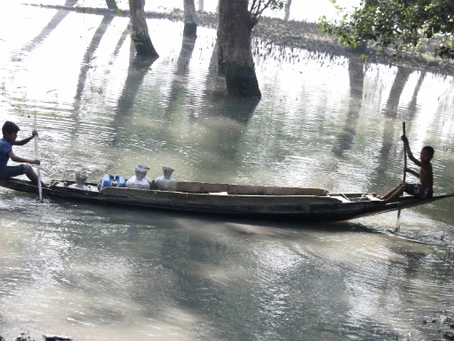Gabura Union, located within the coastal region of Bangladesh, is a resilient community grappling with an escalating water crisis. Situated amidst the confluence of the Kholpetua and Kapotaskha Rivers, the inhabitants face a formidable challenge – the encroaching salinity levels, driven by rising sea levels, rendering nearby water sources unfit for consumption.

For generations, the people of Gabura have depended on agriculture, fishing, and labor-intensive occupations for sustenance. However, the annual inundation of their lands and prolonged waterlogging, exacerbated by soaring salinity, inflict profound hardships. Compounding the issue, a staggering 75% of the coastal population lacks access to safe drinking water, perpetuating a cycle of waterborne diseases and absenteeism, particularly among children.
Not long ago, Gabura’s residents relied on rivers and ponds for their water needs. Yet, today, salinity levels soar to 29.0-30.0 PSU during summer, rendering these sources undrinkable. Even underground water from tube wells, typically a reliable alternative, bears traces of salinity, marking a significant departure from the past when it was pristine.
To address the water crisis, the community has turned to alternative sources such as rainwater harvesting and the use of ponds with pond sand filters (PSF) with the support of NGOs and local governments. These PSFs, equipped with slow sand filter units, treat surface water, primarily from ponds, for domestic use. Water from the pond is pumped using manually operated hand tube wells to feed the filter bed, producing treated water that is generally safe for consumption. Usually, women and children travel 1-2 kilometers away to collect the water.

Yet, these solutions are not without their challenges. There are logistical hurdles of transporting water from PSFs, often situated kilometers away and from a farther distance to bring the water by rikshaw van or boat to their community and sell per jar (around 30 liters) BDT 20-30. Some household-based rainwater harvesting plants are installed with the support of different NGOs, which are also helping people in those areas to get safe drinking water.
In addition, the government, bolstered by development organizations, is making efforts to reduce the distance to PSFs, thereby enhancing accessibility.

In conclusion, Gabura’s struggle against the water crisis embodies resilience and innovation. Despite obstacles, the community’s concerted efforts, supported by government and NGO partnerships, pave the way for sustainable solutions. Through empowerment and collaboration, Gabura exemplifies a beacon of hope, inspiring change beyond its coastal shores.

You can contact the author at [email protected] or on LinkedIn.


